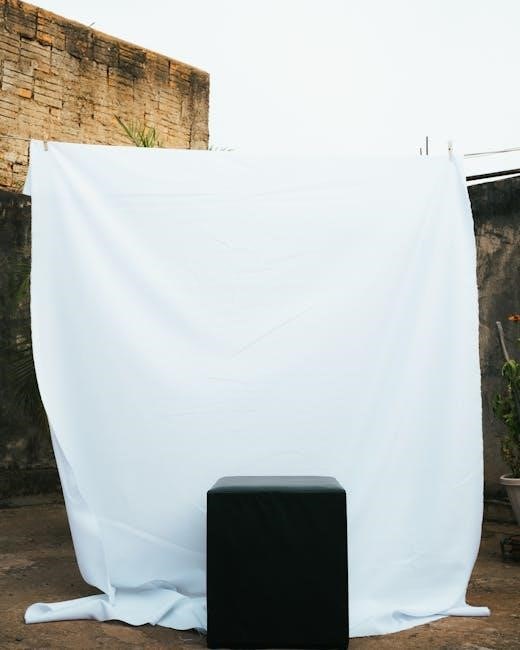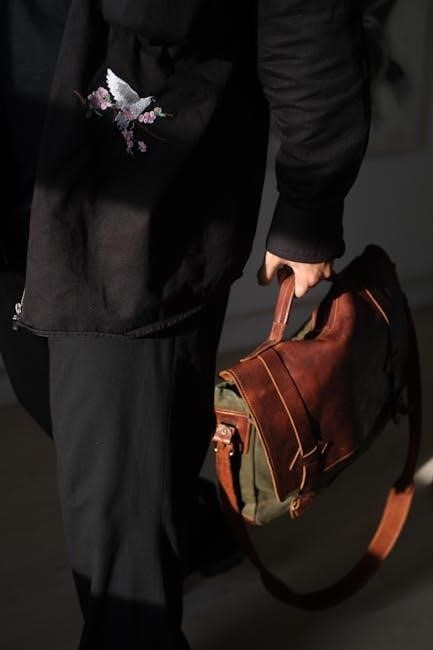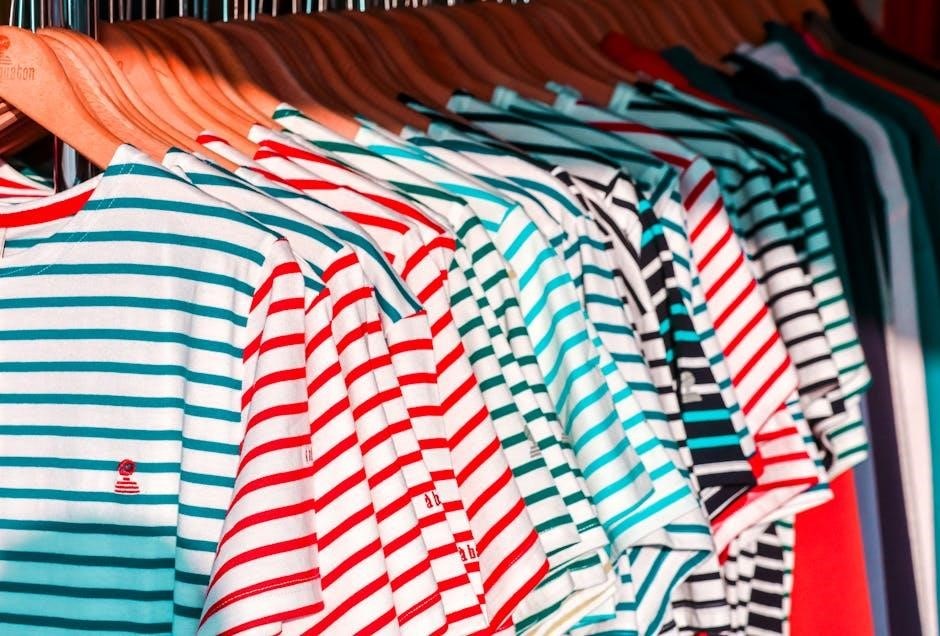fabric weight guide
- Published
- in Guide
Fabric weight is a crucial factor in textile selection, influencing durability, drape, and suitability for projects. This guide explores GSM, fabric types, and how to choose the right weight for your needs, ensuring optimal results in apparel, home decor, and industrial applications.
1.1 What is Fabric Weight?
Fabric weight measures a fabric’s heaviness, typically expressed in GSM (grams per square meter). It indicates the density and thickness of the material, influencing its drape, durability, and suitability for various projects. Understanding fabric weight helps in selecting the right material for specific applications, ensuring optimal performance and aesthetics. This knowledge is key for achieving desired results in sewing and textile work.
1.2 Importance of Understanding Fabric Weight
Understanding fabric weight is crucial for making informed decisions in textile projects. It determines durability, drape, and suitability for specific uses, ensuring optimal performance and aesthetics. Knowing fabric weight helps match materials to project requirements, avoiding common mistakes and ensuring satisfaction with the final product. This knowledge is essential for achieving professional results in sewing, fashion, and home decor applications.
What is GSM in Fabric?
GSM (grams per square meter) measures fabric weight, indicating density and durability. Higher GSM fabrics are heavier and more durable, while lower GSM fabrics are lighter and more delicate.
2.1 Definition of GSM
GSM (grams per square meter) measures fabric weight, indicating density and durability. It quantifies the weight of fabric within a specific area, helping determine suitability for various applications. Higher GSM fabrics are heavier and more durable, while lower GSM fabrics are lighter and more delicate, making GSM a crucial factor in fabric selection and project planning.
2.2 How GSM is Measured
GSM is measured by weighing a fabric sample of 1 square meter (or a smaller sample scaled up). Digital scales or specialized tools calculate the weight in grams. The fabric is conditioned to standard temperature and humidity to ensure accurate results, providing a reliable measure of fabric density and weight for various applications.
2.3 Is Higher GSM Always Better?
Higher GSM does not always mean better quality or suitability. While heavier fabrics (higher GSM) offer durability and strength, they may lack drape and comfort. Lighter fabrics (lower GSM) are ideal for delicate projects. The choice depends on the project’s requirements, balancing comfort, flexibility, and aesthetic appeal with durability, ensuring the fabric meets the intended use effectively.

Fabric Weight Chart
A fabric weight chart categorizes materials into lightweight (under 200 GSM), medium-weight (200-400 GSM), and heavyweight (over 400 GSM), guiding users in selecting fabrics for specific projects and applications.
3.1 Lightweight Fabrics (Under 200 GSM)
Lightweight fabrics under 200 GSM are ideal for delicate projects, offering a soft, airy texture. Common examples include chiffon, voile, and organza. These fabrics are perfect for garments requiring drape, such as dresses or scarves, and are also used in sheer curtains or linings. They are easy to work with but may require careful handling to avoid tears. Ideal for spring and summer designs, lightweight fabrics provide comfort and elegance, making them a popular choice for both apparel and home decor applications. Proper care ensures their longevity, maintaining their lightweight and breathable qualities.
3.2 Medium-Weight Fabrics (200-400 GSM)
Medium-weight fabrics, ranging from 200 to 400 GSM, offer a balance of durability and comfort. Common examples include cotton, polyester blends, and twill. These fabrics are versatile, suitable for clothing like shirts, pants, and home decor items such as upholstery and drapes. They provide structure while maintaining a soft feel, making them ideal for year-round use. Their moderate weight ensures ease of sewing and care, catering to a wide range of projects and preferences.
3.3 Heavyweight Fabrics (Over 400 GSM)
Heavyweight fabrics, exceeding 400 GSM, are robust and long-lasting, ideal for durable applications. Examples include canvas, denim, and thick upholstery materials. These fabrics are perfect for heavy-duty projects, offering exceptional strength and stability. They are often used in industrial textiles, outdoor gear, and structured garments, providing both functionality and resilience for demanding environments and extended use.
Factors Affecting Fabric Weight
Fabric weight is influenced by yarn thickness, weave density, material type, and finishing treatments, impacting durability, drape, and overall quality for various applications.
4.1 Yarn Thickness and Density
Yarn thickness and density significantly impact fabric weight. Thicker yarns and tighter weaves result in heavier fabrics, offering greater durability. Conversely, finer yarns and looser weaves create lighter, more delicate textures. This balance determines the fabric’s strength, drape, and suitability for various applications, making it a key factor in achieving desired textile properties.
4.2 Weave and Construction
Fabric weave and construction play a vital role in determining weight. Tight weaves result in denser, heavier fabrics, while loose weaves create lighter, more breathable textures. The arrangement of yarns influences strength, durability, and drape, making certain weaves more suitable for specific applications, from delicate garments to sturdy upholstery, thus impacting both functionality and aesthetic appeal.
4.3 Material Type and Blends
Different materials and blends significantly affect fabric weight. Natural fibers like cotton and linen tend to be heavier, while synthetics such as polyester can vary widely. Blends combine properties, offering balanced weight and performance. The choice of material directly impacts the fabric’s weight, durability, and suitability for various applications, from apparel to industrial textiles, ensuring optimal functionality and comfort.
4.4 Finishing Treatments
Finishing treatments can alter fabric weight by adding coatings or textures. Processes like waterproofing, softening, or fireproofing enhance functionality but may increase weight. These treatments are crucial for specific uses, ensuring fabrics meet performance standards while maintaining their intended weight category for applications ranging from apparel to technical textiles, thus optimizing both durability and usability effectively.

Applications of Fabric Weight Guide

Fabric weight guides are essential for apparel, home decor, and industrial textiles. They help in selecting suitable materials for specific projects, ensuring functionality, comfort, and durability across various applications.
5.1 Apparel and Fashion
Fabric weight is vital in apparel, determining comfort and durability. Lightweight fabrics like chiffon suit summer wear, while heavier materials such as canvas are ideal for winter coats. Understanding GSM helps designers choose fabrics that balance aesthetics with functionality, ensuring garments are both stylish and long-lasting for various fashion needs and seasons.
5.2 Home Decor and Upholstery
Fabric weight plays a key role in home decor and upholstery, impacting durability and aesthetics. Heavier fabrics like canvas are ideal for sturdy furniture, while lighter materials such as silk or voile are perfect for drapes. Choosing the right weight ensures functionality and style, enhancing interior design and creating a lasting impression in any living space.
5.3 Technical and Industrial Textiles
Fabric weight is critical in technical and industrial textiles, where durability and performance are paramount. Higher GSM fabrics are often used for heavy-duty applications, such as industrial equipment or medical textiles, ensuring strength and longevity. The right weight balances functionality and material efficiency, making it essential for specialized textile manufacturing and industrial purposes.
How to Choose the Right Fabric Weight
Selecting the right fabric weight involves understanding your project’s needs, considering factors like durability, drape, and comfort. Match weight to intended use for optimal results.
6.1 Understanding Fabric Density and Drape
Fabric density and drape are key factors in weight selection. Density refers to how tightly fibers are packed, affecting durability and weight. Drape measures how fabric flows, impacting appearance. Lighter fabrics offer soft drape, while denser ones provide structure. Balancing these elements ensures the right weight for your project, enhancing both functionality and aesthetic appeal.
6.2 Matching Weight to Project Requirements
Choosing the right fabric weight involves considering the project’s purpose, durability needs, and desired drape. Lighter fabrics suit delicate projects, while heavier ones are ideal for sturdy applications. Refer to GSM charts to align weight with intended use, ensuring functionality and aesthetic appeal. Testing samples can also help confirm suitability for specific tasks or designs.
Fabric Quality and Durability
Fabric quality and durability depend on GSM, material type, and weave. Higher GSM often indicates greater durability, but fiber strength and construction also matter significantly.
7.1 Relationship Between GSM and Fabric Strength
GSM (grams per square meter) is a key indicator of fabric strength. Higher GSM typically means denser, heavier, and more durable fabric. However, strength also depends on material type, weave, and fiber quality. While GSM correlates with durability, it’s not the sole determinant, as construction and yarn thickness play significant roles in overall fabric resilience and performance.
7.2 Myths About Fabric Weight and Quality
A common myth is that higher GSM always equals better quality. While GSM indicates weight, true quality depends on factors like material type, weave, and yarn thickness. Lightweight fabrics can be durable, and heavyweight ones may lack softness. Understanding these nuances helps dispel misconceptions and ensures informed fabric selection for specific needs and applications.
Calculating GSM and Converting to Oz
Understanding how to calculate GSM and convert it to ounces is essential for precise fabric selection. Utilize digital tools and resources to ensure accuracy and efficiency in your projects.
8.1 How to Calculate GSM
GSM (grams per square meter) measures fabric weight. To calculate, weigh a 1m x 1m fabric sample in grams. This measurement indicates fabric density and durability. Higher GSM fabrics are heavier and more robust, while lower GSM fabrics are lighter and more delicate. Accurate calculation ensures proper fabric selection for various projects, enhancing both functionality and aesthetic appeal.
8.2 Converting GSM to Oz
To convert GSM (grams per square meter) to ounces, divide the GSM value by 28.35. For example, 200 GSM equals approximately 7.05 ounces. This conversion helps in understanding fabric weight in different units, aiding in project planning and material selection across various applications.

Tools and Resources for Fabric Weight Measurement
Digital scales and online GSM conversion tools simplify measuring fabric weight. These resources provide accurate conversions and measurements, ensuring efficiency in fabric selection and project planning.
9.1 Digital Scales and Measuring Tools
Digital scales are essential for accurately measuring fabric weight in GSM. They provide precise readings, ensuring consistency and reliability. These tools are user-friendly and allow for quick comparisons between different fabric samples, helping to determine the ideal weight for specific projects. Regular calibration ensures accuracy, making them indispensable for professionals and hobbyists alike in fabric selection and quality control.
9.2 Online GSM Conversion Tools
Online GSM conversion tools simplify fabric weight measurements by converting GSM to ounces and vice versa. These web-based resources are easily accessible on phones or computers, offering quick and accurate conversions. They are invaluable for comparing fabric weights and ensuring compatibility with international standards, making fabric selection more efficient and precise for both professionals and DIY enthusiasts.

Visual Comparison of Fabric Weights
A visual guide helps distinguish fabric weights, from lightweight chiffon to heavy canvas, showcasing textures and uses. This tool aids in understanding fabric density and drape effectively.
10.1 From Chiffon to Canvas
From lightweight chiffon (70-100 GSM) to heavy canvas (400-600 GSM), fabrics vary significantly in weight and texture. Chiffon is delicate and flowy, ideal for dresses, while canvas is sturdy, perfect for upholstery or bags. This visual range helps compare fabric densities, drape, and uses, making it easier to select the right material for specific projects based on weight and texture preferences.
10.2 Textures and Uses
Fabric textures vary with weight, from soft, airy lightweight fabrics like voile to sturdy, rugged heavyweight materials like denim. Each texture suits specific uses, such as delicate chiffon for dresses or durable canvas for upholstery. Understanding the interplay between weight and texture helps match fabrics to their ideal applications, ensuring functionality and aesthetic appeal in various projects.

Common Fabric Types and Their Weights
Cotton, polyester, and blends are popular fabrics, ranging from lightweight voile to medium-weight denim. Knit fabrics like jersey are lighter, while woven fabrics like canvas are heavier, offering durability for various uses.
11.1 Cotton, Polyester, and Blends
Cotton fabrics typically range from 150-200 GSM, ideal for lightweight apparel. Polyester fabrics are slightly heavier, around 200-300 GSM, offering durability. Blends combine the breathability of cotton with polyester’s strength, often ranging from 180-350 GSM, making them versatile for various applications, from casual wear to home textiles, ensuring a balance of comfort and longevity.
11.2 Knit vs. Woven Fabrics
Knit fabrics typically have lower GSM, offering flexibility and softness, ideal for garments like t-shirts. Woven fabrics, with higher GSM, provide structure and durability, commonly used in jeans and canvas. The choice depends on the desired texture and use, balancing comfort and strength for various applications.

Care and Maintenance of Fabrics by Weight
Fabric weight determines care needs. Lighter fabrics require gentle cycles and delicate settings, while heavier fabrics can withstand robust wash settings to maintain durability and structure.

12.1 Washing and Drying Guidelines
Fabric weight influences washing and drying methods. Lightweight fabrics require gentle cycles and low heat to prevent damage, while medium-weight fabrics can handle standard settings. Heavyweight fabrics are durable and can withstand robust wash cycles and higher heat. Always check care labels for specific instructions to maintain fabric integrity and extend lifespan.
12.2 Storage Tips for Different Weights

Store lightweight fabrics in breathable bags or folded with acid-free tissue to prevent wrinkles. Medium-weight fabrics can be neatly folded or hung. Heavyweight fabrics should be supported to maintain shape, avoiding creases. Always store in a cool, dry place to preserve quality and prevent moisture damage across all fabric weights.
Common Myths About Fabric Weight
Dispelling myths about fabric weight, higher GSM doesn’t always mean better quality. Lighter fabrics can be durable and suitable for specific uses, like summer apparel.
13.1 Myth vs. Reality in Fabric Selection
Dispelling the myth that higher GSM always equals better quality, the reality lies in purpose. Lighter fabrics, while less durable, offer breathability ideal for summer apparel. Heavier fabrics, though more durable, may lack drape and comfort. Understanding these trade-offs is key to making informed fabric choices.
Conclusion
This guide provides a comprehensive understanding of fabric weight, helping you make informed decisions for apparel, home decor, and industrial projects. Choose wisely based on your needs.
14.1 Summary of Key Points
Fabric weight, measured in GSM, determines durability, drape, and suitability for projects. Understanding GSM, fabric types, and their applications helps in selecting the right material for apparel, home decor, or industrial use. This guide provides a clear framework for making informed decisions, ensuring optimal fabric choices for various needs and applications.
14.2 Final Tips for Fabric Selection
Always consider project requirements, fabric density, and drape when selecting weight. Use GSM as a guide but prioritize material type and weave. Test samples for durability and texture. Utilize GSM conversion tools for accuracy. Match weight to intended use, ensuring functionality and aesthetics align. Refer to fabric weight charts for quick comparisons and informed decisions.
